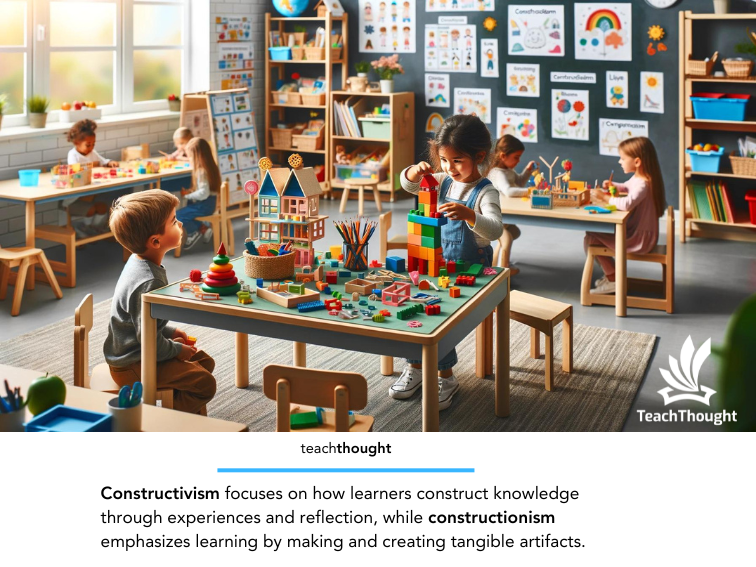The Difference Between Constructivism And Constructionism
by Terry Heick
While working on the learning theory visual overview, I realized I couldn’t clearly explain the difference between constructivism and constructionism.
So I did a little research and initially didn’t find much to ease my confusion.
The Difference Between Constructivism And Constructionism
Constructivism is–more or less–the same thing. So what’s the difference between constructivism and constructivism?
Definition of Constructivism
Constructivism is an educational theory in which learners actively construct their own understanding and knowledge through experiences and reflection on those experiences. It emphasizes the importance of learners’ prior knowledge, social interactions, and contextual learning to build new understanding.
Definition of Constructionism
Constructionism extends constructivist ideas by emphasizing learning through creating tangible artifacts, such as models or projects. It promotes the idea that learners construct knowledge most effectively when they are actively involved in making something that is personally meaningful.
Edith Ackerman, a “Swiss-born American psychologist who explored the interactions between developmental psychology, play, learning and design. A graduate of the University of Geneva, she held permanent or visiting positions at several institutions in the United States and Europe, including the MIT Media Lab,” explained…
“What is the difference between Piaget’s constructivism and Papert’s “constructionism”? Beyond the mere play on the words, I think the distinction holds, and that integrating both views can enrich our understanding of how people learn and grow. Piaget’s constructivism offers a window into what children are interested in, and able to achieve, at different stages of their development. The theory describes how children’s ways of doing and thinking evolve, and under which circumstance children are more likely to let go of—or hold onto— their currently held views.
Papert is interested in how learners engage in a conversation with [their own or other people’s] artifacts…and how these conversations facilitate the construction of new knowledge.
Edith Ackerman, Psychologist
“Piaget suggests that children have very good reasons not to abandon their worldviews just because someone else, be it an expert, tells them they’re wrong. Papert’s constructionism, in contrast, focuses more on the art of learning, or ‘learning to learn’, and on the significance of making things in learning. Papert is interested in how learners engage in a conversation with [their own or other people’s] artifacts, and how these conversations boost self-directed learning, ultimately facilitating the construction of new knowledge. He stresses the importance of tools, media, and context in human development. Integrating both perspectives illuminates the processes by which individuals come to make sense of their experience, gradually optimizing their interactions with the world.”
You can read the full pdf here.


So What Is The Difference Between Constructivism And Constructionism?
Constructivism
Theory Key Idea: How people learn by constructing their understanding and knowledge of the world through experience and reflection.
Influential Theorists: Jean Piaget and Lev Vygotsky
Key Elements Of Constructivism
1. Active Learning: Learners actively participate in their learning process.
2. Knowledge Construction: Learning is about constructing knowledge rather than just absorbing information.
3. Prior Knowledge: Learners build new knowledge based on existing knowledge.
4. Social Interaction: Learning often involves social interactions and collaboration.
5. Contextual Learning: Learning is contextual and situational.
Constructionism
Theory Ley Idea: This approach extends constructivist ideas into learning by making, emphasizing the creation of tangible products or artifacts.
Influential Theorist: Seymour Papert
Key Elements of Constructionism
1. Learning by Making: Knowledge construction is most effective when learners are actively involved in making something tangible.
2. Project-Based Learning: Emphasis on projects that result in a tangible artifact or product.
3. Reflection and Iteration: Learners reflect on their creations and iterate on their designs.
4. Computational Thinking: Often involves integrating technology and computational tools.
5. Personal Relevance: Projects are driven by learners’ interests and personal relevance.
Summary
Constructivism: Focuses on the individual’s process of constructing knowledge through experiences and reflection.
Constructionism: Emphasizes learning by creating tangible artifacts, incorporating technology and personal interests.
Similarities Between Constructivism and Constructionism
Same: Active learning and the importance of prior knowledge
Examples Of Constructivism
Example 1: Learning in a Classroom
Scenario: A science class is learning about ecosystems.
Activity: The teacher sets up stations with various ecosystems (pond, forest, desert) and provides materials such as pictures, plant samples, and soil types.
Constructivist Approach: Students rotate through the stations, observe the materials, and discuss what they notice about each ecosystem in small groups. They then create a concept map showing how different ecosystem elements interact.
Outcome: Through active engagement and discussion, students construct an understanding of ecosystems by connecting new information with their prior knowledge.
Example 2: Child Learning
Scenario: A child is learning about fractions.
Activity: The child is given a set of fraction tiles and a recipe to be halved.
Constructivist Approach: The child uses the fraction tiles to visually and physically manipulate the parts of the recipe, experimenting with different combinations to understand how fractions work.
Outcome: Through hands-on experience, the child understands fractional relationships by actively engaging with the materials and applying fractions to a real-world scenario.
Examples of Constructionism
Example 1: Learning in a Classroom
Scenario: A middle school technology class is learning about coding.
Activity: The teacher assigns a project where students create their own video game using a programming platform like Scratch.
Constructionist Approach: Students brainstorm game ideas, write the code, design characters, and build the game. They test their games, get feedback from peers, and make revisions.
Outcome: Through creating a tangible product (a video game), students deepen their understanding of coding concepts, logic, and problem-solving.
Example 2: Child Learning about a science topic
Scenario: A child is interested in learning about electricity
Activity: The child is given a simple electronics kit with wires, a battery, and a light bulb.
Constructionist Approach: The child is asked to build a basic circuit, experimenting with different connections to see what makes the light bulb turn on. They might also try adding a switch or multiple bulbs.
Outcome: By constructing a working circuit, the child learns about the principles of electricity, circuits, and conductivity through hands-on creation and experimentation.



